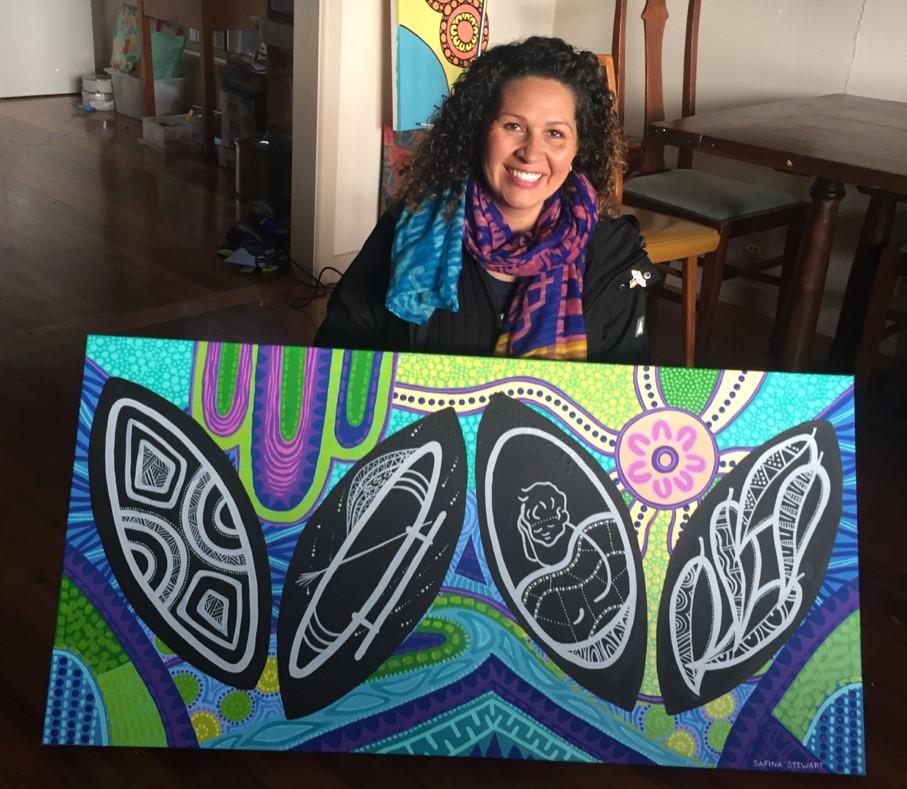The overall theme of the Asia-Pacific Ministerial Conference on Disaster Risk Reduction, From Crisis to Resilience: Transforming the Asia-Pacific Region’s future through disaster risk reduction, focused on capturing and sharing lessons learnt to reduce the risk of disasters across the Asia-Pacific.
With the Asia-Pacific as the most disaster-prone region in the world, the conference provided an important opportunity to review risk reduction efforts, share and learn about innovative and practical solutions, and for countries and organisations to make actionable commitments against the Sendai Framework for Disaster Risk Reduction 2015-2030.
Conference Artwork “Caring” by Safina Stewart

Safina Stewart is an Indigenous Australian artist whose heritage is from Mabuiag Island in the Torres Strait and Wuthathi Country in Far North Queensland. Her non-Indigenous heritage comes from Scotland.
Safina was asked to create an artwork piece to symbolise the APMCDRR themes. The artwork featured prominently across the conference.
The artwork fcontains four black oval message sticks containing four very meaningful elements.
Shield: a message of protection for family, one's own body and self.
Canoe with Fishing Net: a symbol and source of provision for Torres Strait Islanders, and Aboriginal people who live on coastal regions.
Baby in Coolamon: used in women's business for looking after family, collecting food, water, and as a cradle for babies.
Gum Leaves: universally used throughout Aboriginal people groups in ceremonial practice for healing and welcome.
Surrounding symbols show elements of creation such as, beautiful waves from the ocean, mountains and many pathways leading to a campfire, a meeting place where people sit and talk. Patterned Aboriginal and Torres Strait Islander artwork is integrated to symbolise colour and celebration.
APMCDRR sessions were organised around three main pillars and three cross-cutting themes, which informed the content of the program.
INVESTING IN RESILIENCE AND PREPAREDNESS
The compounding impacts of disasters – such as the effects of climate change and the COVID-19 pandemic – have highlighted the importance of systemic risk-informed investment decisions, and the need to further consider the role of financial investment in both mitigating crises and reducing their impact.
Governments, at both the national and local levels, play a key role – including in economic planning and establishing social protection systems to enhance the resilience of affected communities. However, the private sector and communities themselves are critical too. Pillar One explored the roles of various actors in shaping and driving change in financial systems to reduce disaster risk.
SHOCK-PROOFED INFRASTRUCTURE AND SYSTEMS
There is a need to ensure that new and existing infrastructure enables communities and economies to prosper in the face of future challenges.
Given rapid urbanisation, cities and urban areas of all sizes and economic characteristics must embrace technology and make risk-informed infrastructure decisions to support essential social services. Resilient and inclusive infrastructure relies on interconnected systems; and the people that operate and maintain it. Planning and regulatory standards can build resilience in highly dynamic and uncertain environments. Strong leadership and governance at national, sub-national and local levels are required for infrastructure planning and recovery.
RESILIENT COMMUNITIES
Communities are often unprepared for multiple and cascading events, including those driven by climate, conflict and health security.
Disasters affect people differently and exacerbate pre-existing inequalities. To build resilience at the community level, there is a need to better link indigenous knowledge, technology, scientific evidence, planning, decision-making and communication in an all-of-society approach. Local actors are the first responders when a disaster occurs. An inclusive and accessible approach to building resilience, that connects leadership, innovation and expertise at the community level, is vital to ensure no one is left behind.
LOCALISATION
Disaster risk plans must be informed by local knowledge and expertise. Government and civil society actors must have the tools they need to lead the recovery of their own communities. Emphasis was placed on showcasing how local and indigenous knowledge in disaster risk reduction planning can improve outcomes and build inclusive resilience.
INCLUSION
Including women and girls, persons with disabilities, young and aged people and other marginalized groups in disaster risk reduction planning is essential for resilience.
Harnessing these voices and capabilities as first responders, agents of change and leaders in disaster risk reduction will transform resilience at all levels. The conference investigated how to implement inclusive disaster risk reduction through highlighting and mainstreaming inclusive approaches.
SCIENCE, TECHNOLOGY AND KNOWLEDGE
Key to supporting disaster prevention, preparedness and recovery is developing innovative initiatives and harnessing existing knowledge of local communities, including Indigenous expertise.
Scientists and technology end-users, such as local and indigenous communities, shared evidence on how science and technology has increased community understanding and risk communications, along with enhanced capacity for early warning and action.
APMCDRR Spotlight sessions addressed the cross-cutting themes – explore the sessions here.

